Use this list of safe, nutritious, and easy to eat finger foods for baby to help you know exactly what (and how) to offer at meals and snacks. Plus, find the best first finger foods, troubleshooting tips, and visuals of foods broken down by food group to keep things easy!
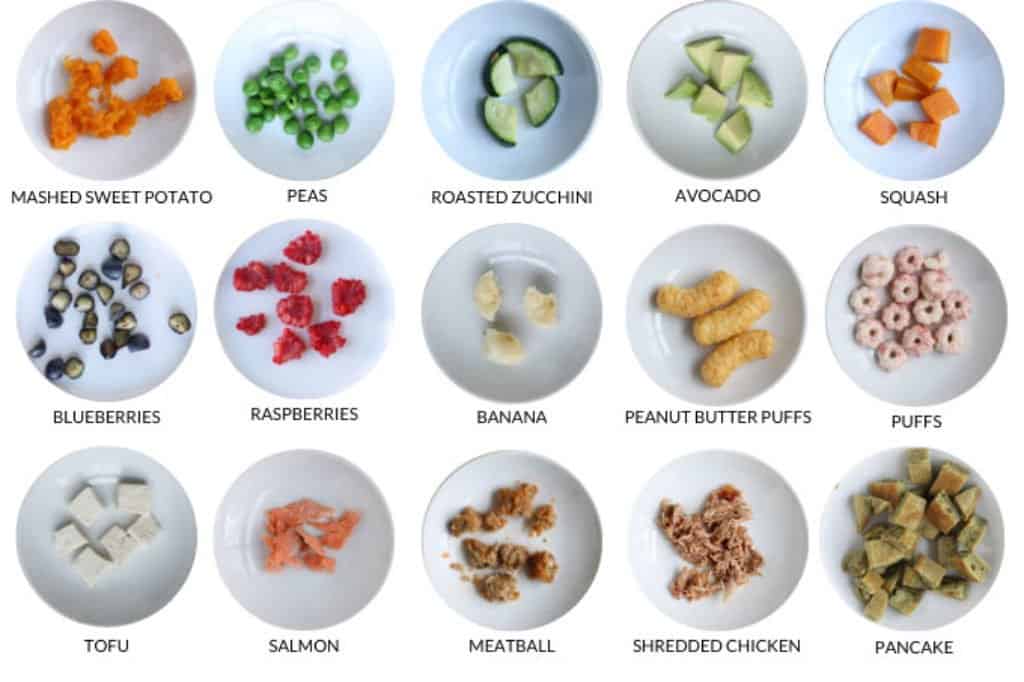
Finger Foods for Baby
After baby starts solids and is ready to move onto finger foods, you may feel a little confused by exactly what to serve and how to serve it. Which is totally normal because it can be scary to let baby feed themselves this way and we may not have any experience doing this—or we may have totally forgotten from our last kiddo!
This list of finger foods for baby will cover some great first finger foods to start with, then set you up with plenty of healthy options from each food group.
TIP: Find more info on starting solids here and the best foods to start with if doing baby led weaning or purees with baby.
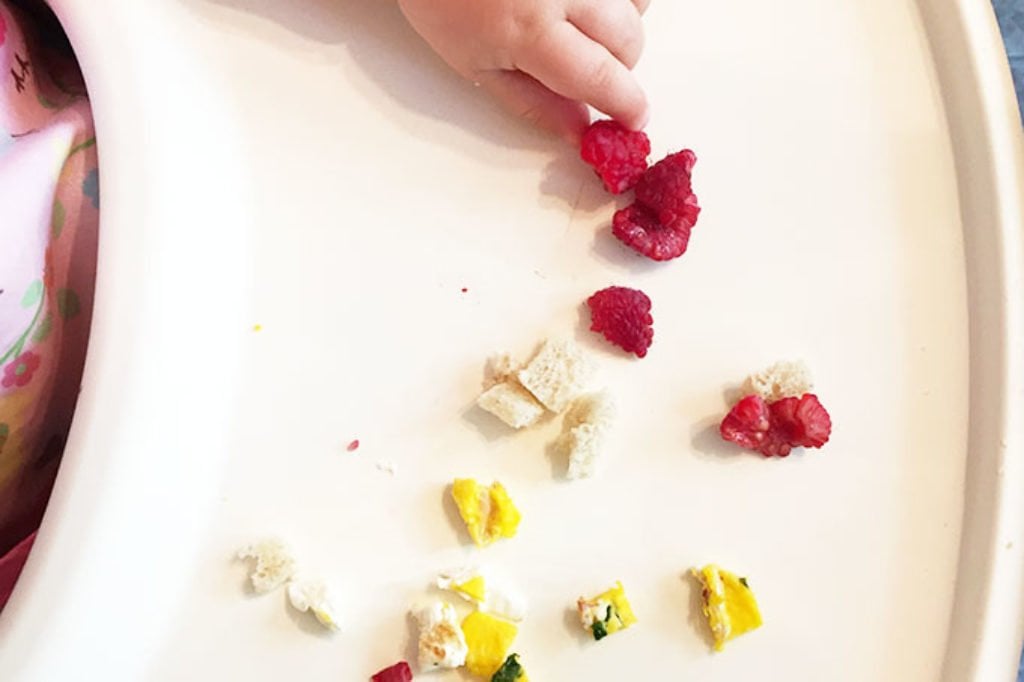
Healthy Baby Food
I love sharing these ideas for baby food since they are easy to prepare and serve and because I know how hard it can be to continue to come up with flavorful and healthy meals and snacks for our little ones. Let me tell you, I’m on my third kiddo and it can be such a challenge to feed him during the chaos of parenting the rest of my crew! These foods are wholesome and nutritious—perfect for your baby.
TIP: I’m a big fan of SpoonfulONE, a company that offers the most complete way to introduce food allergens to our kids. They make mix-ins, puffs, and crackers that are yummy and easy for babies and toddlers to eat. Learn more about their pediatrician-approved baby foods here. (sponsored link)
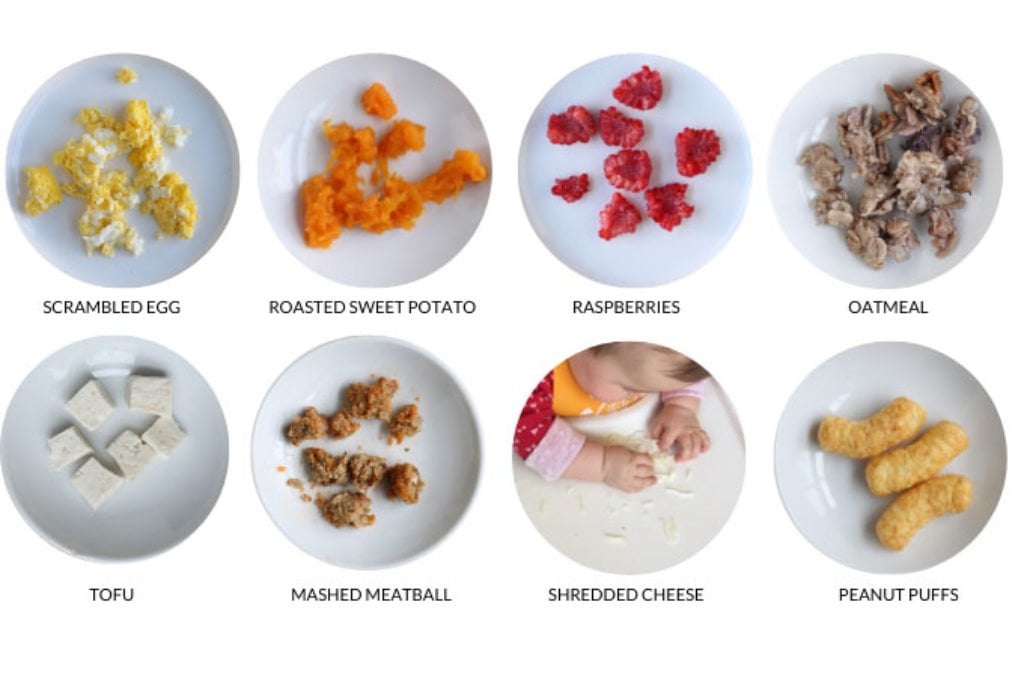 Best First Finger Foods
Best First Finger Foods
When baby is around 9 months, you’ll notice that they’re able to pick up smaller pieces of food with two fingers. This is known as the “pincer grasp” and is a sign that they’re ready to start finger foods. To be clear, when I say “finger foods” I mean small pieces of food that a baby (or toddler) can feed themselves.
Here are some of my favorite ones to start with that are all super soft, safe to eat, and easy to pick up.
- Scrambled egg, broken up into small pieces
- Roasted sweet potato mashed and broken up into small pieces
- Fresh raspberries, broken up into smaller pieces
- Oatmeal, cooked according to package directions and allowed to cool
- Tofu, diced and sauteed lightly or steamed
- Ground beef, chicken, or turkey, broken up into small pieces or lightly mashed meatballs
- Shredded cheese or crumbled goat cheese
- Mashed sweet potato, in little pieces
- Peanut butter puffs
TIP: You can serve the tofu, ground meat, or meatballs in veggie puree from a pouch or a simple marinara sauce for extra moisture and flavor. Learn more about how and why to introduce peanut butter.
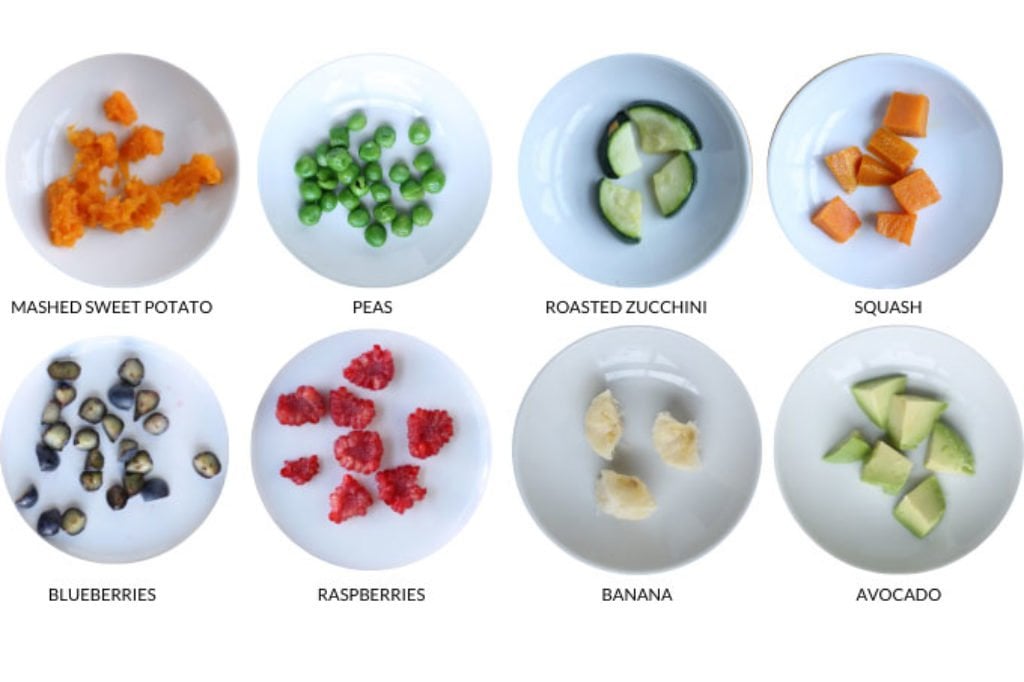 Finger Foods for Baby: Fruits and Veggies
Finger Foods for Baby: Fruits and Veggies
Some of my favorite early fruits and veggies to serve babies are:
- Mashed roasted sweet potato, broken up into small pieces
- Warmed frozen peas, slightly mashed if desired
- Roasted Zucchini
- Diced Roasted Sweet Potato or Butternut Squash
- Fresh blueberries, cut in half or quarters
- Fresh raspberries, broken into small pieces
- Banana, broken into small segments (they are less slippery this way versus slicing them)
- Avocado, diced and mashed slightly (be sure it’s ripe and very soft)
TIP: A good rule of thumb is to serve pieces of food that are about the size of a pea to start and soft enough that they are easy to squish between your fingers. This will be easy for baby to pick up and eat and will also reduce chances of choking.
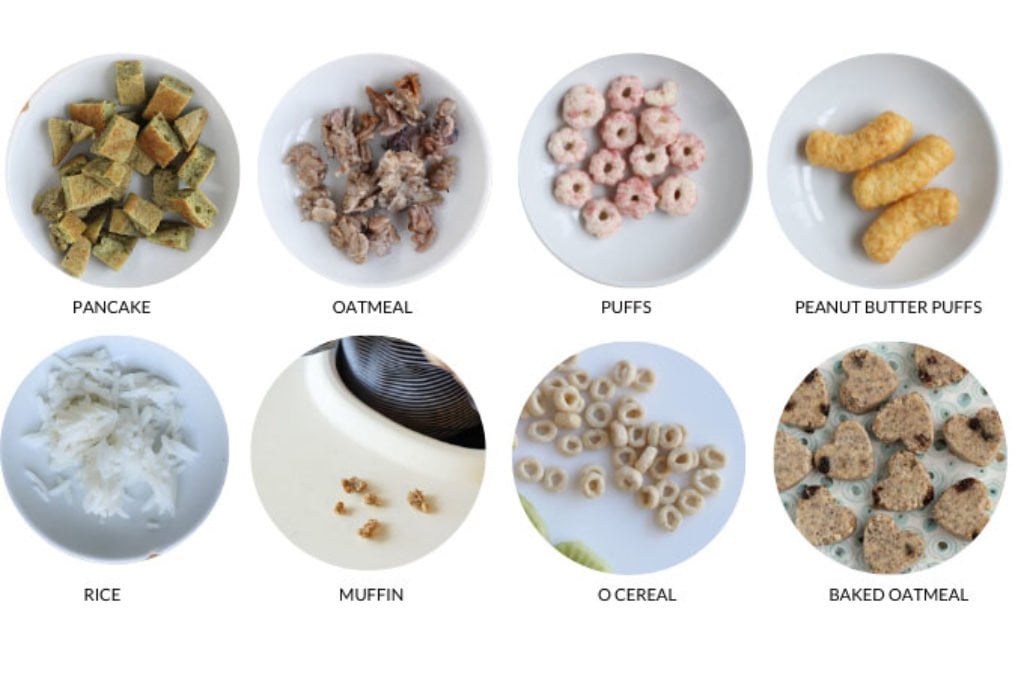 Finger Food Ideas: Carbohydrates
Finger Food Ideas: Carbohydrates
Offering complex carbohydrates can provide fiber, a variety of textures, B vitamins, and more. Try these with your baby.
- Spinach pancakes (moisten with applesauce or plain yogurt if needed; this recipe is particularly moist and great for babies)
- Oatmeal, cooked according to package directions and allowed to cool
- Baby Puffs
- Peanut Butter Puffs
- Rice (it’s easiest if it’s in little clumps so baby can pick it up; this Coconut Rice or this Cheesy Rice are both good options)
- Baby Banana Muffin
- O cereal (soften in nondairy unsweetened milk or yogurt as needed)
- Baked Oatmeal, diced
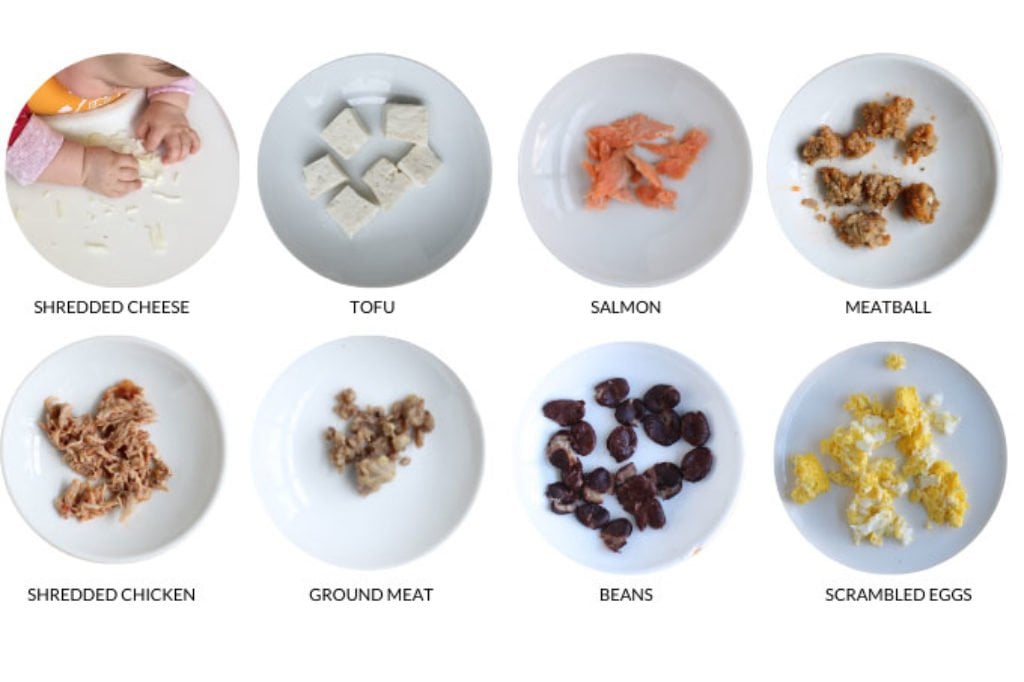 Finger Food Ideas: Proteins
Finger Food Ideas: Proteins
Offering proteins will continue to expose baby to a range of nutrients. These are my go-tos for babies newer to finger foods—and toddlers too.
- Shredded cheese (thicker cuts are a little easier to pick up)
- Tofu, diced and sauteed lightly or steamed
- Flaked cooked wild salmon
- Lightly mashed meatballs
- Shredded chicken, cut up finely (we love this Butter Chicken to share with baby)
- Ground beef, turkey, or chicken, broken into smaller pieces
- Lightly mashed beans
- Scrambled eggs, broken up into small pieces
- Diced egg muffins
I’d love to hear any questions you may have, or if you have foods that your babies enjoy that I didn’t include here. Chime in below in the comments!
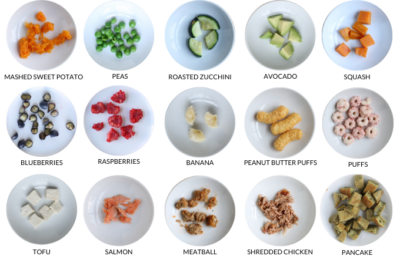
Best Early Finger Foods for Baby
Ingredients
First Finger Foods (choose 1-3 per meal)
- 1 Scrambled egg (broken up into small pieces)
- 1/4 cup Roasted sweet potato, mashed and broken up into small pieces
- 1/4 cup Fresh raspberries (broken up into smaller pieces)
- 1/4 cup Oatmeal (cooked according to package directions and allowed to cool)
- 2 tbsp Tofu (diced and sauteed lightly or steamed)
- 2 tbsp ground beef, chicken, or turkey, broken up into small pieces or lightly mashed meatballs
- 2 tbsp shredded cheese or crumbled goat cheese
- 1/4 cup Mashed sweet potato (broken into little pieces)
- 1/4 cup Peanut butter puffs
Fruits and Veggies
- 1/4 cup mashed roasted sweet potato (broken up into small pieces)
- 1/4 cup warmed frozen peas
- 1/4 cup Roasted Zucchini
- 1/4 cup diced Roasted Sweet Potato or Butternut Squash
- 1/4 cup blueberries (cut in half or quarters)
- 1/4 cup raspberries (broken into small pieces)
- 1/4 cup banana slices (broken into small segments—they are less slippery this way versus slicing them)
- 2 tbsp avocado (diced and mashed slightly—be sure it's ripe and very soft)
Whole Grains and Carbohydrates
- 1 Spinach pancakes (moisten with applesauce or plain yogurt if needed; this recipe is particularly moist and great for babies)
- 1/4 cup Oatmeal (cooked according to package directions and allowed to cool)
- 1/4 cup Baby Puffs
- 1/4 cup Peanut Butter Puffs
- 1/4 cup fully cooked rice (it's easiest if it's in little clumps so baby can pick it up; this Coconut Rice or this Cheesy Rice are both good options)
- 1 Baby Banana Muffin
- 1/4 cup O cereal (soften in nondairy unsweetened milk or yogurt as needed)
- 1/4 cup Baked Oatmeal (diced or regular oatmeal broken into little pieces)
Dairy
- 2 tbsp Shredded cheese (such as mozzarella)
- 2 tbsp Tofu (diced and sauteed lightly or steamed)
- 2 tbsp flaked cooked wild salmon
- 1 lightly mashed meatballs
- 2 tbsp finely shredded chicken (we love this Butter Chicken to share with baby)
- 2 tbsp ground beef, turkey, or chicken (broken into smaller pieces)
- 2 tbsp lightly mashed beans
- 1 Scrambled egg (broken up into small pieces)
- 1 Diced Egg muffins
Instructions
- For each meal or snack, choose 2-3 foods from a mix of food groups. Aim to include some fat in most meals and protein in many too.
- Prepare the food, cutting into small pieces and/or mashing as needed to make the food easy to eat.
- Start with small portions and allow more as baby indicates according to their hunger.
Notes
- Store leftovers in an airtight container for 3-5 days in the fridge.
- Many foods you cook for your family will work as baby finger foods—just be sure they are easy to squish between your fingers and the pieces are small and easy to chew.
- Babies very normally make a lot of faces when they eat, so don't assume they don't like something just because they scrunch their nose!
- Flavors and textures can take time to learn to eat, so continue offering foods in small portions even if baby hasn't liked them in the past—and make sure they taste good to you!
Nutrition
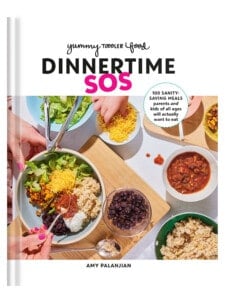
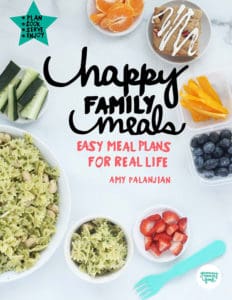
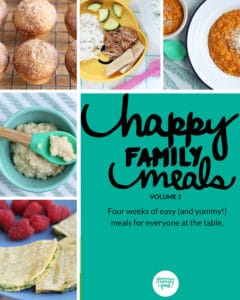
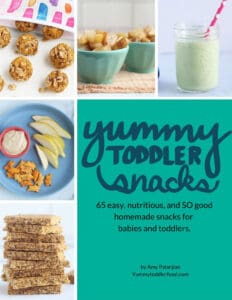










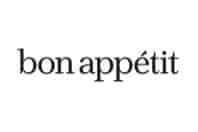
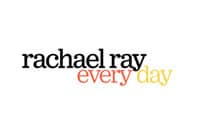


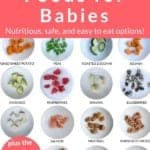
Thank you for putting this list together! Sometimes I get caught up with everything else and tend to feed my baby the same 4-5 things over and over. I’ll use this when I need to mix things up a little.
One thing I do that isn’t on your list is baked apples. Peel them, cut them in thicker slices, add a little cinnamon, and bake til soft. Once they’re done I cut them into smaller chunks for little hands.
Also, around 9 months my son stopped wanting purées but I still had a bunch of them stocked up. I started mixing them or serving them with a little cottage cheese and the added flavor/texture allowed me to use up the purées I had.
Thanks for adding that!
Hi. I have a 10 month old. He acts like he can eat anything table food wise. But I still have left over purée. I’m trying to get rid of them. But still introduce him to different vegetables and fruit purée he hasn’t tried. Is it possible to try your way? Just to get rid of his purées?
You can simply include both types of foods in his meals.
Hello Amy,
Thank you for this wonderful article on baby finger foods. I would like to ask permission to use the images you provided on serving size and cut portions for a poster I am creating for other moms. It will not be used for profit but as an educational piece. It would just be a poster with serving sizes based on the fruit, vegetables, and other food items related to baby finger foods.
P.s. I have personally used your serving size and food ideas for my 10-month-old, and I have certainly seen improved motor functions and independence for grabbing his own foods.
Hi- if you could email me the full info to amy @ yummytoddlerfood.com that would be great. Thank you!
We are doing purees with my 9 month old and he is eating quite a bit. He isn’t putting food to his mouth. Should I continue to do purees and still offer food for him to explore? I just worry that if I give purees at the same time as finger foods, he isn’t going to really learn how to put food in his mouth. What would you suggest we do to ensure that he is learning to put food in his mouth but not compromising on his calories.
thanks!
Hi- If you haven’t tried handing him the spoon so he can feed himself, that would be a great option to try. I would do that and also put some other finger foods on his tray and give him the chance to try. It’s possible he just needs time to get there. (You can also put some of the same finger food in front of yourself and pick it up so he sees you doing it.) With the preloaded spoon, you put some food on it, hand it to him, and then encourage him to hand it back so you can fill it back up. Some families even put the bowl of puree in front of the child with a thick spoon they can easily grip and let them feed themselves. (Yes, it’s messy.) There’s no one right way, but those are some options.
Hi
My almost 9 months doesn’t want purees and not taking enough finger foods, any ideas on what to do
Hi- I would try to make sure that the food is easy for them to eat, that they aren’t hungry for their milk/formula when offering food (since that could be distracting) and have them sit at the table while you eat so they can see you and engage with you while eating. Some kids are less into food than others and can take more time to be interested in solids.
Thank you very much for this post. I was after ideas for some healthy snacks for my baby and am so glad I stumbled onto this page. You have given me some great options.
Currently I give the baby cucumber pieces. I have found they aid his teething gums. However I notice you do not mention cucumber pieces on your post. Any reason why not?
It can be soothing for gums, though if they’d by accident get a big piece in their mouth, it could be a choking hazard since it’s not easy to chew. You could start cutting the slices more thinly to help prevent that (or if that doesn’t seem to be an issue with the way you’ve been serving it, follow your gut)
Thank you so much for such a thorough and informative post! Personally, BLW does not work for me, so I am grateful to have found you! What method do you call this (more traditional) form of introducing finger foods to infants? 😌
You’re welcome! I’m not sure it has a name other than the more traditional “stage 3 baby food”
Hi! My 10-month-old is only starting to cut a couple of teeth. Are these finger foods ok for babies without teeth?
Yes, babies primarily use their gums to chew so it doesn’t matter how many teeth they have!
“A good rule of thumb is to serve pieces of food that are about the size of a pea to start. This will be easy for baby to pick up and eat and will also reduce any chances of choking.”
No offense, but this is exactly the opposite of correct, and it’s dangerous. Round things the size of peas are the most choking hazard, cause baby’s windpipe is about the same diameter as a pea, and pea will be a perfect tight fit, baby might be unable to cough that out. Before they can chew, if it falls down the throat, and gets lodged then baby’s in trouble. Small things like peas are ok mashed, until the baby’s at least 1yo.
Another important point, baby can feed themselves from 6 month old, no need to wait until 9 moths, just offer bigger things that they can grab with whole fist. My 6 months old does brilliantly with things like broccoli florets (she sucks off the little green flowers at the top), roasted sweet potato sticks the size of adult finger, fish fingers (with the breadcrumbs taken off), roasted parsnips cut lengthwise, etc. Anything that’s not too hard, and they can grab with whole fist and practice putting in their mouth. Mashed food obviously works too. You can still do purees alongside if you want. No point waiting until 9 months, 6 month old baby benefits greatly from the opportunity to play with their food, even if most of the time it will end up on the floor (at 6mo they don’t need a lot, as most nutrition they still get from milk, food is mostly about the experience).
Hi- Thanks for the comment. If you read the line you quoted again, you’ll see that I’m using the size of a pea as an example of size. And when I mention peas specifically further down in the post, I mention that they can be mashed. Also, it’s so great that your baby did well with BLW. That is a wonderful method, but it’s not right for every family. This post is not saying that you can’t do finger foods until 9 months, it’s just giving options of the types you can do at that age.
Amy this article you wrote touched me and I needed it. I am in so many BLW groups and no. Make me feel as safe and well informed as what you took good time and experience to write and share. I am soo thankful I found this and read it! I am now put at ease to feed my baby.
Most BLW groups don’t offer help they just give you general guidelines that you can get anywhere. This dove in deeper for me.
Thank you thank you thank you!!
My son is almost 10 months an he can feed himself now. He doesn’t have a big appetite to eat. How can I get him to eat finger foods that will fill him up that he will like?? I’ve tried a few finger foods like sweet potatoes and blueberries, but when it comes down to eat he doesn’t want it.
If he doesn’t have a big appetite, he likely won’t eat a lot of food—that’s what you’d want him to be doing, trusting his appetite. A lot of kids take longer to have larger appetites, especially if they are breastfeeding or having bottles, so that may go up as his milk intake goes down. I would follow his appetite and try to remember that there is a big range of what’s “normal” as far as intake. If he’s growing, gaining weight, and meeting milestones and is following his own hunger cues, those would all be normal positive signs of growth and development for his age (not a specific amount of food intake).
My Lo is about to be 7 months and I would like some ideas other than purees as a ftm on foods to introduce to him that will also make me feel confident giving them to him.
None of the foods here are purees so let me know what other sorts of examples you’re looking for!